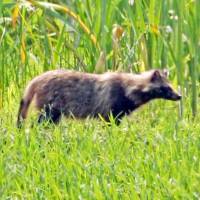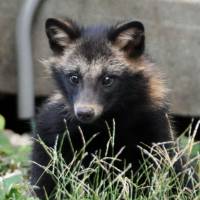After deer, easily the most commonly seen wild mammals up here in the Kurohime hills where I live, and in northern Nagano Prefecture in general, are the furry, short-legged burrowing creatures called tanuki in Japanese.
If you look up that word in older Japanese-English dictionaries you'll find it translated as "badger," but that's wrong because these omnivorous animals, whose native range spans many countries of East Asia, are classified in the family Canidae — which includes domestic dogs, wolves, foxes, jackals and coyotes. Hence they're entirely different from the Mustelidae to which badgers (along with otters, weasels, martens, ferrets, minks and wolverines) belong.
More modern dictionaries will tell you that tanuki means "raccoon dog," but that is extremely misleading because, although they slightly resemble raccoons, they are very different — and they're certainly not dogs that either hunt, herd or guard raccoons.
Tanuki's scientific name, Nyctereutes procyonoides, is said to derive from Greek words meaning something like "night-wandering proto-dog" — but who's going to remember that?
In Japanese, though, tanuki are sometimes called mujina, but since that word is also used for badgers, which are otherwise known as ana guma (meaning "hole bears"), things can get even more confusing — especially as it is fairly common for tanuki and badgers to share burrows or live in ones close to each other.
Interestingly, in the earthy way of folk, there is a saying in Japanese about both these mujina sharing the same hole — a saying that's used to make a snide reference to humans who share the same unpleasant characteristics.
But back to basics: Even in English, I always call these animals we most often see scurrying out of car headlights at night "tanuki" — never raccoon dogs or badgers.
Though they keep out of sight better there, plenty of them also live in our Afan Trust woodlands. Now there's snow on the ground, their tracks are everywhere and it's plain to see how they scuffle along through it on their short legs quite unlike foxes, which step daintily like fashion models, one paw behind the other.
However, even those of you living in urban Japan will likely encounter these animals, too — in the form of the portly porcelain figures sporting big grins and even bigger testicles that are often placed at the entrance of izakaya (Japanese pubs), sitting there on their haunches clutching a flagon of sake as they welcome customers.
Meanwhile, in Japanese folklore and many traditional legends, tanuki are frequently portrayed as mischievous shape-changers that like to trick people. In real life, if they are suddenly surprised they will feign death, like an opossum — which is perhaps one reason why so many are hit by vehicles and killed on country and suburban roads. To their cost, they are also not as agile and nimble as foxes.
Like foxes in London, the tanuki are quite common in suburban Tokyo, and two tribes of them inhabit the Imperial Palace grounds. One tribe is very traditional in its dietary habits, while the other will eat pretty well anything.
How can this be known? Well, tanuki often tend to defecate in the same place, a sort of communal toilet, so by examining the droppings a biologist can find out what they are eating.
Because of this habit, tanuki are great spreaders of seeds from the kinds of wild berries and other fruits they like to eat, so when we clear out densely crowded trees in our woods to let the light in, they always seem to cooperate in bringing the understory back to life.
Although they are indigenous to regions of East Asia, tanuki were taken to many parts of Russia, and to Poland and elsewhere, to be raised for their fur, and there they have since spread into the wild.
In Japan's snow country, such as where I live, you'll sometimes come across references to tanuki jiru (tanuki stew), and when I moved to Kurohime in 1980 and joined its hunting association in order to learn about the mountains, woods and rural customs, I wanted to try everything. Consequently, at one post-hunt dinner I tucked into a tanuki stew made with tanuki meat, burdock, Japanese leeks, daikon radish and miso paste — while downing lots and lots of sake.
Believe me, you needed the sake to wash it down! I have lived with minority and indigenous peoples all over the world, and have tried and usually enjoyed some pretty unusual and sometimes smelly foods — but tanuki stew is something I don't ever need to try again.
The first taste was quite good, and it certainly warms a person up after a long cold tramp in the snow. But then the lingering smell is hard to describe — a bit like skunk with an added fragrance of burned rubber.
I fancy myself as a cook, so when given tanuki meat by my local hunting friends I tried cooking it myself.
First, I removed the fat, which is smelly. Then I cut up the meat and soaked it for a while in cold, slightly salted water. Then I washed it in more cold water. I boiled it in an iron pot, repeatedly removing the scum. I then added the burdock and removed more scum. Then came the white radish, and even more scum. Finally I added the leeks and the miso paste and simmered gently for a couple of hours, adding sake both to the pot and myself to sweeten things up. And the taste? Hardly any difference.
Since then, the only wild mammals I've prepared as food here in Japan have been deer, wild boar, bear and hare.
When I see a tanuki, and especially the young ones, I can't help smiling. To me, they are really cute. Yes, they do some damage to the fields, but nothing like that done by deer, wild boar, bears or monkeys.
Their numbers seem to be controlled by cyclic attacks of mange, a debilitating skin disease caused by parasites, or by a form of the viral disease distemper, which the tanuki almost certainly get from domestic dogs and perhaps cats. Right now, though, those in our areas seem very healthy indeed: fluffy, furry and fat.
The only tanuki I don't like at all are the ones in human form — those that Japanese people call tanuki jiji (old tanuki men). This subset of the species has a reputation for falsehood, trickery and blatant deception — and this year, especially, they seem to be scuffling all over and around the national Diet.
Me, I prefer the ones out here in the countryside.






